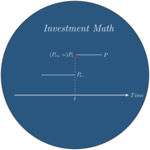Exam (2018)
This is the exam for the 2018 ensae course.
Exercise 1
The investment universe is composed of \(N\) risky assets (indices \(i=1,\ldots,N\)) with expected returns \(\mu=(\mu_{1},\ldots,\mu_{N})'\) and covariance matrix \(\Sigma\) (dimension \((N,N)\)) which is assumed non singular. A portfolio is a vector \(\pi\) of size \(N\) which records the proportions invested on the assets. The proportions sum to \(1\), i.e. \(\pi'e=1\) where \(e\) is the vector of size \(N\) where each component is equal to \(1\).
Given a return objective \(\bar{\mu}\), we are looking for the portfolio with the lowest possible level of risk. Give the corresponding optimization problem. Derive the Lagrangian, noting \(\gamma\) the multiplier of the return constraint and \(\delta\) the multiplier of the full investment constraint.
What is the first order condition corresponding to the optimum ? For which portfolio do we get \(\gamma=0\) ?
We consider an optimal portfolio \(\bar{\pi}\) with \(\gamma \neq 0\) and return \(\bar{r}\). Show that the first order condition for this portfolio can be written as: \[\text{cov}(r_{i},\bar{r})=\gamma \mu_{i}+\delta.\]
Show that: \[\text{var}(\bar{r})=\gamma \bar{\mu}+\delta,\] and: \[\beta_{i}(\bar{\mu}+\frac{\delta}{\gamma})=\mu_{i}+\frac{\delta}{\gamma},\] where \(\beta_{i}\) is the beta of asset \(i\) against portfolio \(\bar{\pi}\).
We now consider portfolio \(\tilde{\pi}\) with return \(\tilde{r}\) satisfying: \(\text{cov}(\tilde{r},\bar{r})=0\). Let \(\tilde{\mu}\) be its expected return. Show that for asset \(i\): \[\mu_{i}-\tilde{\mu}=\beta_{i}(\bar{\mu}-\tilde{\mu}).\] This is called a one factor representation of expected returns.
Only one efficient portfolio does not give rise to a one factor representation of expected returns. Which one ?
Inversely, assume that portfolio \(\bar{\pi}\) with return \(\bar{r}\) gives rise to a one factor representation: \[\beta_{i}(\bar{\mu}-\rho)=\mu_{i}-\rho,\] for all \(i\), where \(\beta_{i}\) is the beta of asset \(i\) with respect to portfolio \(\bar{\pi}\). Show that we have the following vectorial relationship: \[\Sigma \bar{\pi}=\gamma \mu + \delta e,\] where \(\gamma\) and \(\delta\) are constants associated to the one factor representation.
Conclude that portfolio \(\bar{\pi}\) (the portfolio which generates the given one factor representation) is a solution to the problem defined in the first question. As a reminder, in the context of convex objective function and linear constraints, the first order condition attached to the Lagrangian is both necessary and sufficient to define a solution.
Exercice 2
We consider the following continuous time investment problem. The investment universe is composed of two assets, cash with constant rate of return: \[\frac{dD_{t}}{D_{t}}=r dt,\] and a risky asset that follows a geometric diffusion process: \[\frac{dP_{t}}{P_{t}}=\mu dt+\sigma dB_{t}=r dt+(\mu-r)dt+\sigma dB_{t},\] where \(B_{t}\) is a scalar Brownian motion. The price of risk is defined as \(\lambda=(\mu-r)/\sigma\).
At each point in time, wealth \(W_{t}\) is invested to finance a consumption flow \(C_{t}dt\) over the time interval \([t,t+dt]\). The fraction of wealth invested on the risky asset at time \(t\) is noted \(x_{t}\).
Give the stochastic differential equation followed by wealth assuming consumption is zero. As a reminder, this is the infinitesimal version of the discrete time equation. Give \(E_{t}[dW_{t}]\) (the drift of wealth) and \(d[W]_{t}\) (the quadratic variation of wealth).
Same question without assuming \(C^{t}=0\).
At each time \(t\), the investor maximizes: \[E_{t}\left[\int_{t}^{T}e^{-\rho (u-t)}u(C_{u})du\right],\] by making consumption - \(C_{t}\) - and investment - \(x_{t}\) - choices. The associated value function is noted \(J(t,W_{t})\). It is admitted that the dynamic programming principle implies the following partial differential equation (HJB): \[0=\max_{(C_{t},x_{t})}\left[ u(C_{t})-\rho J+\frac{\partial J}{\partial t}+\frac{\partial J}{\partial W}E[dW_{t}]+\frac{1}{2}\frac{\partial^{2} J}{\partial W^{2}}d[W]_{t} \right].\]
We will use the following notations: \[\frac{\partial J}{\partial t}=J_{t},\] \[\frac{\partial J}{\partial W}=J_{W},\] \[\frac{\partial^{2} J}{\partial W^{2}}=J_{WW}.\]
Give the optimal consumption rate \(C_{t}^{*}\) as a function of \(J_{W}\) and the utility function.
Give the optimal risky asset weight \(x_{t}^{*}\), outlining the relevant property of the value function underlying your reasoning.
Describe the structure of this solution.
We now assume the utility function is: \[u(C)=\frac{C^{1-\alpha}}{1-\alpha},\] with \(\alpha>1\) and admit that the value function has a similar structure: \[J(t,W_{t})=h(t)^{\alpha}\frac{W_{t}^{1-\alpha}}{1-\alpha}.\]
Show that: \[\frac{C^{*}_{t}}{W^{*}_{t}}=h(t)^{-1},\] and: \[x_{t}^{*}=\frac{1}{\alpha}\frac{\lambda}{\sigma}.\]
Show that at each date \(t\): \[u(C^{*})-J_{W}C^{*}=\frac{\alpha}{1-\alpha}J_{W}^{(\alpha-1)/\alpha},\] \[J_{W}Wx^{*}(\mu-r)+\frac{1}{2}J_{WW}W^{2}\sigma^{2}x^{*2}=-\frac{1}{2}\frac{J_{W}^{2}}{J_{WW}}\lambda^{2}.\]
Injecting the above results into HJB, prove that \(h(\cdot)\) solves the following differential equation: \[h'+\frac{1}{\alpha}\left[-\rho+(1-\alpha)r+\frac{1-\alpha}{2\alpha}\lambda^{2}\right]h+1=0,\] with \(h(T)=0\).
Find the solution \(h(\cdot)\).
Give the stochastic differential equation followed by log wealth and log consumption.
